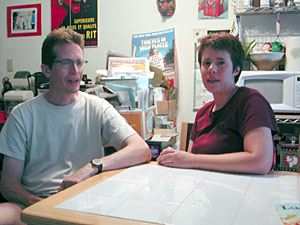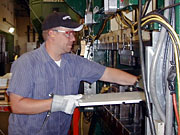The recovery is in the eye of the beholder
September 14, 2004
 |
| Angie Arnold and her husband, Jack Kronebusch, are neither falling behind, nor getting ahead. They have seen any increase in wages eaten up by rising costs of things like gas, health care and milk. (MPR Photo/Andrew Haeg) |
St. Paul, Minn. — The results of our query were decidedly, unequivocally, mixed.
In a way, it was not a surprise to find that perceptions of the health of the economy differed as greatly as individuals' experiences do. But it was instructive to remember that there are many different takes on the economy -- each made valid by personal experience.
|
It feels like we're treading water. And it gets tiring after a while when you can't put your feet down.
- Angie Arnold of Edina |
Bob Cameron, a probation officer from Minneapolis, summed it up: "You have the haves and the have nots. And each side feels strongly about their views. So the haves are very strongly making their point that 'things are good, things are the upswing. I'm doing OK, everybody else I know is doing OK.' And the have nots are saying, 'How can you feel that things are good when I don't have a job and I can't take care of my family and do what I would like to do?'"
Of course, it is overly simplifying things to talk about just the haves and the have nots. But, to Cameron's point, economic data points both to growing wealth, and stronger headwinds for those who are less well off. Recent comments by Federal Reserve Chairman Alan Greenspan suggest that a fledgling rebound is slowly becoming a more sustainable recovery. The economy is slowly adding jobs. But wage growth is sluggish. And rising costs of things like gas, health care and milk means some families are seeing discretionary dollars disappear even after getting a raise at work.
"We're not falling behind, but we're not getting ahead," says Angie Arnold. Arnold works at a non-profit, and is married with a young child. "It feels like we're treading water," she says. "And it gets tiring after a while when you can't put your feet down."
Other Minnesotans seem to be experiencing continued prosperity. The median price of a house is close to $200,000, and builders continue to build homes worth five or six times as much. Other anecdotal evidence, from nicer, bigger cars on the roads to full and overflowing parking lots at retail hubs suggest that many Minnesotans are doing well, or at least appear to be.
Rob, an engineer from Champlin sees an economy that is churning along quite nicely. "People are working, people are buying." he says. "It's one great big revolving circle that just doesn't seem to be ending."
And there is yet another group of Minnesotans who have contentedly sat out both the economic downturn and the rebound. Theirs are the boats that remained in dry dock while the rest rose or sank.
 | |||
Jeff Locke, a legal researcher, says, "I haven't noticed {the economic downturn} at all. I haven't noticed it with friends, neighbors, relatives, acquaintances. It's like it never happened." But Locke has noticed long lines at restaurants, airplanes full of American tourists, more Lexus 330's in his company's parking lot. He knows from reading the newspaper that there are more poor people -- he just doesn't see them.
Statistics and anecdotal evidence confirm that the number of poor people is growing -- food shelves are seeing increases in the number of clients, and social service providers are reporting an increase in requests for public assistance.
"I don't see anything recovering," says Deb Brunsberg, a child support officer for Hennepin County. She says the average person doesn't see the part of society not experiencing a recovery. "I don't think people really see the other side of society unless you really have a job like this. There's a great segment of the population that has nothing. Or has little. Or works 40 hours a week and still can't pay the rent. I think there is a lot of prosperity, and I think people tend not to want to think about people who aren't in the same situation as they are."
The gulf in economic experiences has become more pronounced as the presidential candidates have canvassed the country staking out their positions on the state of the economy, and their vision for managing it (as much as a president can). It may be helpful in these next few months to remember that the variety of experiences defies any attempts to see the state of the economy as all one thing, and not another.
Andrew Haeg is project coordinator for Minnesota Public Radio's Public Insight Journalism initiative.
|
News Headlines
|
Related Subjects
|

